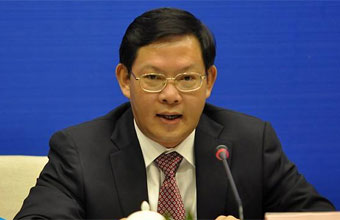Home> Biz Updates
Latest innovations employed in mega projects
Baosteel Group plans to complete construction on the first blast furnace system of its massive iron and steel facility in Zhanjiang in Sept 2015, ahead of schedule.
The project requiring an overall investment of more than 50 billion yuan ($8 billion) will turn out 8.2 million tons of iron and 8.7 million tons of steel, said Sheng Genghong, general manger of Baosteel Zhanjiang Steel Co Ltd.
"Everything moves on smoothly as planned and I am confident we will finish construction ahead of schedule. Originally we planned to have the first blast furnace system go into operation in Dec 2015," said Sheng.
Even with overcapacity in the steel sector, Sheng said "what we really need is to upgrade the industry by kicking out the outdated capacity and improving product quality to enhance competitiveness".
The Ministry of Industry and Information Technology recently announced new targets to reduce obsolete capacity. Compared with the government report delivered by Premier Li Keqiang in March, the new goal is 1.7 million tons higher.
According to Zhang Tieshan, a senior analyst from industry information site Mysteel.com, the central government faces such serious environmental problems that policies to eliminate obsolete steel mills had to be revised.
The lack of rational distribution of factories also leads to extremely high costs in the steel sector.
Guangdong is famous for its manufacturing industries as it plays an important role in the country's auto and electronic appliances industries, and all of these industries need steel.
"After the establishment of the Zhanjiang Baosteel project, it is not necessary for companies in those industries to transport steel from northern China, greatly cutting their costs," said Sheng.
That is one reason the top management at Baosteel decided to reduce production in Shanghai and set up the new project in Zhanjiang.
"Guangzhou Iron & Steel Enterprises Group has shut down its Zhujiang and Baihedong complexes," said Sheng.
One of the major challenges of the project, Sheng said, is to cope with the increasingly strict criteria in environmental protection.
Clean production
He said state-of-the-art technologies will be applied to remove nitrous oxide and sulfur from waste gas. The facility will also employ advanced equipment to collect dust.
By recycling, multi-purpose utilization rate for solid waste will surpass 99 percent, while the internal recycling rate in the steel plant will reach 32.5 percent, both highly challenging standards to reach.
A three-party coordinating committee will be set up among the two mega projects in Donghai Island and the city government to address the issues in building a circular economy, said Zhanjiang Mayor Wang Zhongbing.
The second massive project is an oil refinery built and operated by Sinopec and Kuwait Petroleum Corp.
A core design institute and an expert committee are also necessary, Wang said.
The steel plant and oil refinery will operate on a circular system using each other's waste while sharing infrastructure to improve efficiency. The plants are being built only 500 meters apart.
One plan is to use hydrogen from the steel mill's coke-oven gas to serve as a catalyst in the petrochemical plant, according to Sheng.
The recycling economy also reflects Zhanjiang's efforts in balancing environmental protection and growth, according to Wang.
Pollution is inevitable in the course of industrial development, Wang said, but the important thing is to keep emissions in check.
|
The first blast furnace system of the Zhanjiang Baosteel project is scheduled for completion in Sept 2015. [Photo provided to China Daily] |

 Print
Print Mail
Mail
 5G construction supports Zhanjiang's high-quality development
5G construction supports Zhanjiang's high-quality development
 Acting mayor inspects project construction in Xuwen, Leizhou
Acting mayor inspects project construction in Xuwen, Leizhou Zhanjiang island an "egret paradise"
Zhanjiang island an "egret paradise"  Dancing egrets add vitality to Xiashan
Dancing egrets add vitality to Xiashan